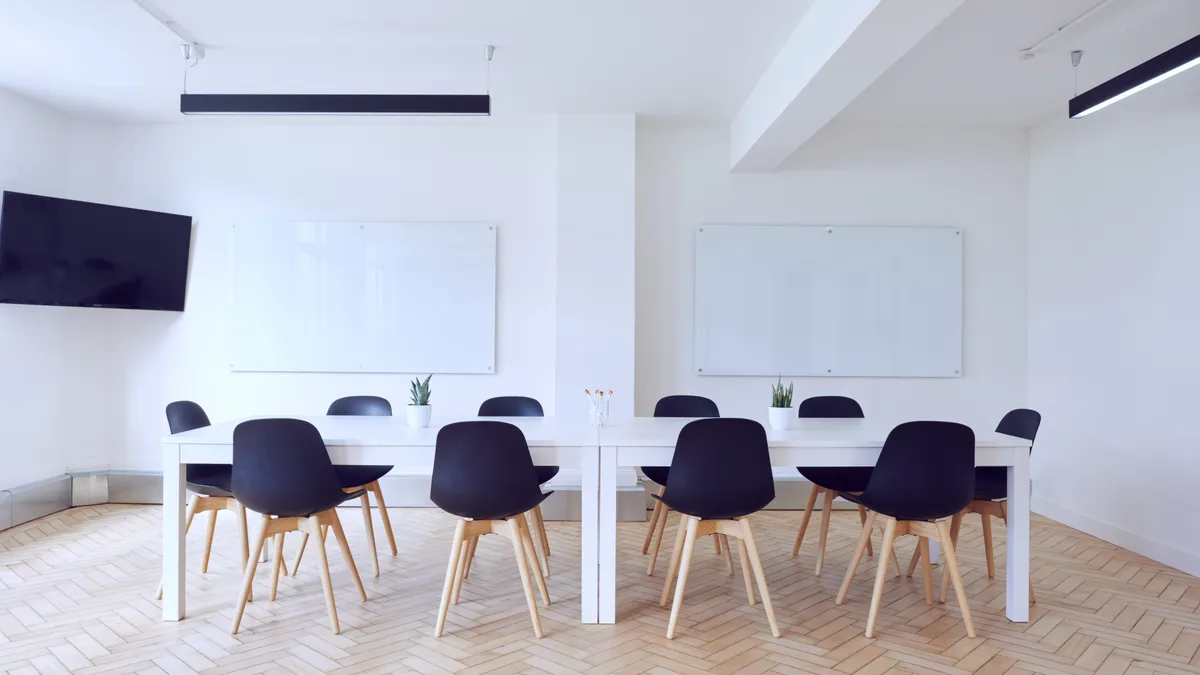Editor's note: The following is a contributed piece by Cristina Herrera, manager of workplace strategy at Ted Moudis Associates, an architecture and interior design firm.
It seems that every day, we hear of another company that has shifted to a free address strategy in which there is no assigned seating and employees are free to choose different locations within the office to work throughout the day. It’s easy for workers introduced to this type of space to feel like they’ve lost their sense of belonging and comfort. We are used to having a dedicated workspace at the office where we can be found by our co-workers and where our personal items are within arm’s reach.
Fortunately, there are a number of ways to create community and continuity in this new environment. Whether you’re a team member or a leader, below are some tips to help get you settled and comfortable again.
Maintaining familiarity
While communication and trust are important foundations for any successful work relationship, they are even more essential in activity-based work environments. Reflect on your existing relationships and connections in your previous workplace layout. These connections likely became stronger or more developed because of long-term physical proximity or through close working relationships. This is natural — we as humans crave familiarity, and an unchanging work environment breeds the comfort necessary to forge and maintain these connections.
There are advantages to the familiarity that traditional work environments can establish, yet there are ways to maintain those advantages while embracing an activity-based environment. Here are three great ways to retain the benefits gained from sitting among friends and teammates regularly:
1. Goal setting and communication
Talk to your manager about holding a team huddle first thing every morning. This is a chance for you to begin your day with a familiar group of people and build a rhythm of operating in this new space. Clever leaders will start to develop these habits in old spaces and carry them into the new environment.
2. Commitment to relationship building
Leveraging strong, existing relationships to build structure, familiarity and camaraderie will be essential in acclimating to your new space.
-
Write down the two people you socialized with most, the two people you went to for help, and the two people you were starting to build relationships with in your old workspace. With each group of people, schedule regular weekly or biweekly discussions around what’s working and what’s not, the opportunities this new workplace provides for you personally and your team, and what you’d like to see more of.
-
Understanding the purpose and vision behind the change in environment and/or ways of working is important. When you are successful in finding the benefits for yourself, you are more likely to positively acclimate and become a leader in your environment. Your success is really in your hands.
3. Support resources
It’s very likely that your organization hasn’t evolved to a new work environment and strategy all willy-nilly. Familiarize yourself leading up to, during, and after the change to understand the impetus behind it. How does your company operate now? What is changing and why? How does this affect you and how you work?
Learn where to find support resources, which should offer insight to the rationale behind the space’s design and may provide you with some tips on how to use the space effectively and productively. This information might be found on an intranet site, in a staff guidebook, etc.
Similarly, look for a support person, e.g. team leader or change ambassador, whom you can contact for questions. They should be able to better answer your personal and day-to-day questions about operating in this new environment. They have been educated to understand the thinking behind the new space and are there to help guide you through the transition process.
New opportunities
1. New relationships
Take some time to reflect on the new people you see around you. Perhaps you recognize faces but don’t know them because they were always in their cubicles/workstations/offices. Building new personal relationships in the space will help alleviate the feeling that you are now surrounded by a sea of unfamiliar people every day.
While this may seem daunting, make it your mission to meet three new people daily. A casual hello on the elevator might evolve into a quick chat at your locker, which may lead to a coffee break. Soon you will be scheduling coffee or lunch dates and inviting new people to join in with your friends from existing relationships.
2. Focus on what works for you
Feeling comfortable in your new work environment will take time, but the ideal way to understand your surroundings and what works best for you is to purposefully try it out. Genuinely focus on the items you need to complete daily and look around to see how many different types of work settings are available to help you achieve your tasks.
Remember that this new activity-based working environment is designed to give you freedom and choice in how you do your work. While you may have guiding principles on how to operate within the space, you have the liberty to be as creative and innovative or as predictable and methodical as you like. There is no right or wrong way, as long as you can do your best work and feel successful. Go out on a limb and try as many work settings as possible to find out what works for you — you might be surprised. Doing this will give you a sense of familiarity and ownership of your space.
Play to your culture and identity
An open address workplace may lead to feelings of lost identity, as there is no longer a desk or office to personalize. However, look at this change as an opportunity to create a stronger community and collective identity. Your organization’s identity should be more than a sign on the wall or knick-knacks on a table. It should provide an opportunity to live, play with and experience a newfound culture. This will develop community within your organization and create a palpable ‘personality’ that shines through to your clients and customers.
A communal identity can’t be manufactured or forced through formulaic cause-and-effect processes, but every organization has the potential to foster cultural growth through investment in social, community-building efforts. Leaders should work with their peers to develop engaging strategies in the new workplace to both build and reflect culture and identity.
The strategies below provide a jumping-off point for your organization’s own cultural initiative:
-
Speak to leaders about organizing some team or neighborhood bonding activities, such as a pizza day, birthday celebrations or ‘getting to know you’ activities.
-
If you have lockers, locker decorating competitions with pre-set incentives (gift cards, happy hour, an extra vacation day) are a fun way to promote creativity and social connection between coworkers.
-
If you have neighborhoods in your new space, try gathering corresponding teams to develop an identity or theme. And remember — there is no right or wrong way. Your theme might be world destinations, favorite foods, activities, or sports teams. Allocate time together to personalize your neighborhood to match your team identity. Dedicate some blank space using a wall, bulletin board or whiteboard to express this team spirit.
Leaders who find themselves questioning what they can do to build connectedness and familiarity in a new workplace are not alone. Initiating a team meeting can help a company collectively determine which strategies can be put in place to achieve this unity.
Bottom line
While it might initially seem daunting to move to a free address office environment, there are many fun and creative ways to build and embrace the new environment and celebrate your culture. Exciting and innovative ideas are important, and you may love some of the tips I’ve provided, but the success of these strategies depends on the people themselves and their willingness to get involved and take ownership over their new work environment.
Correction: In a previous version of this article, the author's name was misspelled. The company name, Ted Moudis Associates, was also misidentified.



















